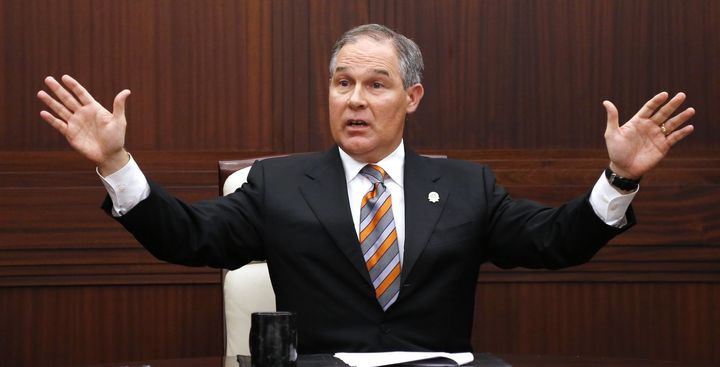
In a recent Wall Street Journal editorial, Steve Milloy concocted a spectacular — and fictitious — tale of corruption within the Environmental Protection Agency. Mr. Milloy accused the EPA of stacking the Clean Air Scientific Advisory Committee, or CASAC, with scientists that were friendly to the agency’s position on the health risks from small particulate matter so that it could implement a series of unnecessary and restrictive policies under the guise of protecting human health.
How did the EPA do this? Milloy argues that the agency conspired against the government and the American people by engaging in what could best be characterized as a years-long racketeering scheme. According to Mr. Milloy’s conspiracy theory, the agency recognized during the 1990s that it was not getting support for its policies on particulates from its independent science advisors. So, the agency felt the need to stack the scientific deck in its favor.
Following Milloy’s theory through to its logical conclusion, the EPA would have initiated what could best be described as a complicated long-con. It would have begun with the awarding of research grants to independent scientists who were studying health risks associated with particulate matter. Years later, with these grateful scientists in the agency’s pocket, EPA Administrators appointed successively by Bill Clinton, George W. Bush, and Barack Obama, would have started to offer them seats on CASAC so they could offer recommendations that were more in line with the agency’s unnecessarily restrictive stance on the chronic health risks associated with exposure to fine particulates. Going further with Milloy’s theory, the agency operating under the administration of Barack Obama, would have heaped even more money on the CASAC scientists to seal their cooperation in the conspiracy.
There are several errors and obfuscations in Mr. Milloy’s theory.
One is the suggestion that CASAC and the Science Advisory Board (SAB)—which Mr. Milloy also lumps into his conspiracy theory—can directly influence EPA policy making. Neither can. Yes, it is true that both boards are charged with reviewing the scientific basis of some potential EPA rules. However, these boards don’t review the rules themselves, and they have no discretion to select the cases that are placed before them; both of those jobs fall to the Administrator. So, if an Administrator appointed by Bill Clinton in the 1990s didn’t want to receive a conflicting opinion about particulates, the solution would have been simple: Don’t ask EPAs independent science advisors for a review.
But, let’s say for a minute that an EPA Administrator did ask for a review. Accepting, or indeed rejecting, input from the EPA’s advisory boards is also at the Administrator’s discretion. So, any EPA Administrator who wanted to exclude external scientific peer review from the agency’s rule making could do it much more easily than by engaging in a multi-year and, importantly, illegal conspiracy.
Milloy serves up his conspiracy theory to justify the recent dismissal of many of the EPA’s independent science advisors, and he uses it to call for EPA reforms aimed at reducing bias and restoring the agency’s integrity. Milloy argues that the only way to do this is through a combination of congressional action and steely-eyed administrative resolve from Scott Pruitt. In Milloy’s words, the problem is that the EPA is rife with conflict-of-interest, which could have been eradicated years ago were it not for the threat of a Senate filibuster or Obama veto.
Here again, Milloy fails to point out that all of the EPA’s independent science advisors—whether they are from industry or the academy—since both groups are already represented on the agency’s advisory boards—must undergo rigorous ethics and conflict-of-interest reviews. Indeed, EPA science advisors undergo the same set of reviews as other special federal government employees appointed under the administration of Donald Trump. If a conflict is found to exist, these advisors must either be disqualified from weighing in on matters where they are conflicted, or they must be disqualified from service on the advisory boards altogether.
Milloy also neglects to mention that it is the EPA Administrator who has the final say, after the ethics and conflict-of-interest reviews have been completed, on the membership of the agency’s scientific advisory boards. So, if an Administrator wanted more—or less—of a certain kind of advisor, he or she could simply make that decision both unilaterally and discretely. There’d be no need for making a lot of headline-grabbing and potentially counterproductive noise; that is, unless, it was what you were intending to do all along.
Finally, Milloy also fails to understand the two-way nature of conflict-of-interest. Even if one were to believe that the federal conflict-of-interest rules were flawed, tipping them in favor of academic scientists beholden to a corrupt agency, it takes an enormous leap of faith to believe that EPA science advisors from a regulated company or industry would magically be inoculated against the very same accusations of bias.
But, Mr. Milloy’s most egregious act of misdirection is the one that is at the very heart of his conspiracy theory. Though it is entirely befitting of the man who created the widely-ridiculed and easily debunked website junkscience.com, it is irresponsible to suggest that small particulates from smokestacks and tailpipes don’t pose a risk to human health. Just ask the thousands of people who live with, or are at risk of contracting lung cancer because of their chronic exposure to small particulates. Or, ask physicians and scientists at the Centers for Disease Control and Prevention. That is unless Mr. Milloy also suggests that these independent patients, doctors, and scientists are all accomplices in the EPA’s grand conspiracy.
Dr. Joe Árvai is the Director of the Erb Institute for Global Sustainable Enterprise at the University of Michigan. He is also a member of the EPA’s Science Advisory Board. He can be reached on Twitter at @DecisionLab.
